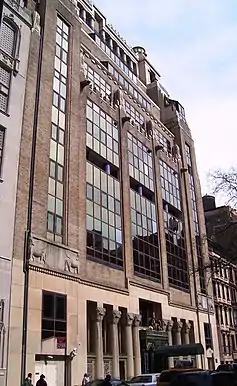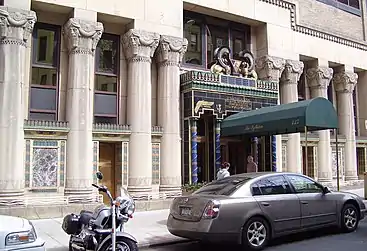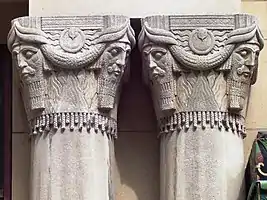Pythian Temple (New York City)
The Pythian Temple is a historic Knights of Pythias building at 135 West 70th Street between Columbus Avenue and Broadway in the Lincoln Square neighborhood of Manhattan, New York City, in the U.S. state of New York. It was built in 1927 to serve as a meeting place for the 120 Pythian lodges of New York City,[1] and later for many years housed a recording studio. Today it is an 88-unit luxury condominium building known as The Pythian.[2]

History
As the organization's popularity declined, in the early 1940s the Pythians leased space in the building to Decca Records, which created a music recording studio in it, transforming a very large third floor auditorium with balconies and wooden floors.[3] On April 12, 1954, Bill Haley and His Comets recorded their single "Rock Around the Clock" – and subsequently recorded all but two of their Decca recordings between 1954 and 1964 – at the Pythian.
On October 21st, 1958 Buddy Holly's final studio sessions were recorded at the Pythian. Known by Holly fans as "The String Sessions", Holly recorded four songs in an innovative collaboration with the Dick Jacobs Orchestra. These songs were: "True Love Ways" (written by Buddy Holly), "Moondreams" (written by Norman Petty), "Raining In My Heart" (written by Felice and Boudleaux Bryant) and "It Doesn't Matter Anymore" (written by Paul Anka).
Other artists who recorded there included Sammy Davis Jr., and Billie Holiday.[1][3] It was in use as a recording studio for over fifteen years.[3]
In a televised interview, Henny Youngman once said he "took violin lessons" at the Pythian as a young man. This may not have been an embellishment since he was born in 1909 and the Pythian was built in 1927, meaning Youngman was 18 by then.
Days after the Soviet suppression of the Hungarian Revolution of 1956, actor and Communist Party activist Paul Robeson spoke at the Temple. He, audience members, and a number of Pythians who had not attended the speech were pelted with eggs and fruit by angry demonstrators as they left the building.[1]
In 1958, the building was purchased by the New York Institute of Technology as that college's main campus. Decca's recording studio, however, remained in use into the 1960s.
In 1986[4] the building was converted to residential use by architect David Gura for which he won a Residential Design Award from the New York Chapter of the American Institute of Architects.[5] The facade underwent a restoration in 2008–9.[1]

Architecture
The building is a flamboyant Egyptian Revival Temple in Art Deco style.[4][6] It was designed by Thomas W. Lamb, an architect noted for designing theaters. He created "a midblock facade of movie-set Egyptian forms, seated Pharaonic figures, polychrome columns and a setback arrangement ... Inside, there were 13 lodge rooms and an auditorium decorated in a striking Egyptian manner."[6]
In addition to the thirteen lodge rooms and the spacious theater, the building had a gym and a bowling alley. The theater had Broadway-quality staging facilities for the fraternal association's professionally produced pageants.[1]
In 2009, the architectural historian Christopher Gray wrote in The New York Times:
The Pythian Temple's ground-floor colonnade, with Assyrian-type heads, is centered on a brilliantly glazed blue terra-cotta entry pavilion. The windowless middle section steps back at about 100 feet up, with four seated Pharaonic figures similar to those of Ramses II at Abu Simbel. Two more setbacks rise to a highly colored Egyptian-style colonnade, and to giant urns carried by teams of yellow, red and green oxen. In a rendering, the urns are lighted with fires. Published photographs of the lobby show a double-height space in what appears to be polished black marble, with Egyptian decor, like a winged orb, or perhaps Isis, over the doorway.[1]

Notable residents
The parents of singer Lady Gaga moved into the building in 1993.[7]
Robert Altman lived in the building from the 1990s until his death in 2006.[8]
References
- Notes
- Gray, Christopher (2009-06-18). "An Improbable Cradle of Rock Music". New York Times. Retrieved 2009-09-05.
- NYC Architecture listing for The Pythian
- Simons, David (2004). Studio Stories - How the Great New York Records Were Made. San Francisco: Backbeat Books. Cf. pp.168-169.
- Willensky, Elliot; White, Norval, The A.I.A. Guide to New York City, Third Edition (Harcourt Brace Jovanovich, 1988). Cf. especially p.357 on the Pythian Temple.
- David Gura website
- Gray, Christopher (2003-08-24). "Recalling the Days of Knights and Elks". New York Times. Retrieved 2009-09-05.
- "Lady GaGa house profile" on the Celebrity Detective website
- "Robert Altman archives at the University of Michigan"
External links
| Wikimedia Commons has media related to Pythian Temple (New York City). |